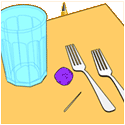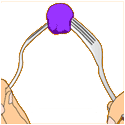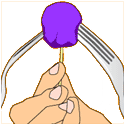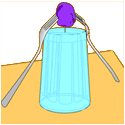



Experiment Category:
Objective:
What You Need:
- Two metal forks
- Modeling clay
- Flat toothpick
- A drinking glass or wide mouth jar
To Do and Observe:
1. Make a ball of clay about the size of a large marble.
2. Insert the tip of one of the forks into the clay ball. HINT: The stronger your clay, the better your experiment will work.
3. Insert the second fork at about a 45-degree angle from the first fork.
4. Insert the pointed end of the toothpick in the clay between the forks.
5. Place the end of the toothpick on the edge of the glass.
6. Move it further over the glass until the forks balance. If the forks do not balance, decrease the angle between them.
7. Make any other adjustments until the forks balance.
What's Going On:
The angle of the forks spreads their weight so that there is one place on the toothpick where all of the weight seems to be located. This spot is called the center of gravity. If you suspend an object from any point, let it go and allow it to come to rest, the center of gravity will lie along a vertical line that passes through the point of suspension. Unless you've been very careful in balancing the object, the center of gravity will generally lie below the suspension point.
Parent/Teacher Tips:
Find a soft surface like a rug or grass and attempt a headstand. Begin by placing your head on the ground. Then try to balance your knees on your elbows to form a crouched headstand. Now extend your legs straight up into the air. See how long you can hold your position. Make any necessary adjustments to balance yourself and see if you can improve your time. You should notice that there is a point in your position that allows you to balance your entire body. Any disruption in this position will result in a loss of balance.
